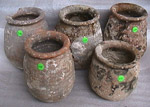| Discovering Asia's
ceramic development |
The Singtai
ship (+/- 1550)
This wreck was discovered in 53 metres of water, 12 nautical miles from the
nearest island. Only the surface of the site has been investigated, with a few
ceramic artefacts recovered. The ship appears to be of South China Sea type,
and approximately 22 metres in length. During the few dives on the site (in
very limited visibility), hundreds of large Singburi storage jars were noticed
- similar to jars on the Xuande site. These may have been the main cargo.
Some Sukhothai and Sisatchanalai underglaze products were found, but as already
noted, no celadon. Maybe blue-and-white, by now being exported in volume from
China, had changed the competitive balance and forced the Thais to modify their
product?
The Singtai could be contemporary with the Xuande, but seems
likely to be slightly later. The star motifs on the Sukhothai bowl shown top
left, for example, are stamped. Solar whorl designs on other bowls, like those
on the Xuande, are hand-painted.
Sisatchanalai underglaze covered boxes (top right) and bottles were found on
both ships. No plates or dishes have been found in the Xuande or Singtai
cargos.
Some other Sisatchanalai ware on this wreck is unusual. The potiche or covered
jar shown bottom right has a brown glaze, which as far as we know has not been
seen elsewhere, although the same shape has been found with an opaque white
glaze. Some jarlets are spotted with brown glaze. Brown-glazed items from Sisatchanalai
had previously been found on the Turiang.






